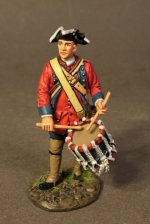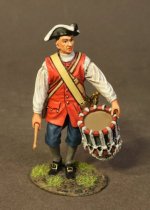THE EIGHTEENTH CENTURY COLLECTION
DRUMS ALONG THE MOHAWK
Walter D. Edmonds wrote about the area of upstate New York and detailed the lives of pioneer farmers along the Mohawk River during the American Revolution.
Edmonds wrote "The Matchlock Gun," which was about a 10-year-old boy defending his home against Indians in colonial New York, and won the Newbery Medal for Children's Literature in 1942.
He also wrote about four women captives of Indians in 1778 in his 1947 book "In the Hands of the Senecas,"
Edmonds' books are considered the richest body of fiction about the time and region since the works of James Fenimore Cooper.
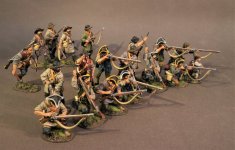
The initial sets for this series will include militia, wagoneers, and more girls with guns, all suitable for the American Revolution and French and Indian War periods.
These figures can be used for the Battle of Oriskany, fought on August 6, 1777, which was one of the bloodiest battles in the North American theater of the American Revolutionary War and a significant engagement of the Saratoga campaign. An American party trying to relieve the siege of Fort Stanwix was ambushed by a party of Loyalists and allies of several Native American tribes, primarily Iroquois. This was one of the few battles in the war in which almost all of the participants were North American: Loyalists and allied Indians fought against Patriots and allied Oneida in the absence of British regular soldiers.
Early in the siege of Fort Stanwix, an American relief force from the Mohawk Valley under General Nicholas Herkimer, numbering around 800 men of the Tryon County militia, and a party of Oneida warriors, approached in an attempt to raise the siege. British commander Barry St. Leger authorized an intercept force consisting of a Hanau Jäger (light infantry) detachment, Sir John Johnson's King's Royal Regiment of New York, Indian allies from the Six Nations, particularly Mohawk and Seneca; and other tribes to the north and west, and Indian Department Rangers, totaling at least 450 men.
The Loyalist and Indian force ambushed Herkimer's force in a small valley about six miles (10 km) east of Fort Stanwix, near the present-day village of Oriskany, New York. During the battle, Herkimer was mortally wounded. The battle cost the Patriots approximately 450 casualties, while the Loyalists and Indians lost approximately 150 dead and wounded. The result of the battle remains ambiguous. The apparent Loyalist victory was significantly affected by a sortie from Fort Stanwix in which the Loyalist camps were sacked, spoiling morale among the allied Indians.

DAM-06A
DRUMS ALONG THE MOHAWK,
2 CIVILIANS ,
(2pcs)
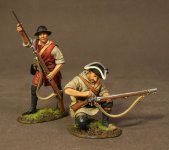
DAM-06B
DRUMS ALONG THE MOHAWK,
2 CIVILIANS ,
(2pcs)

DAM-07A
DRUMS ALONG THE MOHAWK,
2 CIVILIANS ,
(2pcs)
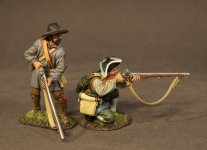
DAM-07B
DRUMS ALONG THE MOHAWK,
2 CIVILIANS ,
(2pcs)
The series will also attempt to cover probably the most significant battle of the American Revolution.
The two Battles of Saratoga were a turning point in the American Revolution. On September 19th, British General John Burgoyne achieved a small, but costly victory over American forces led by Horatio Gates and Benedict Arnold. Though his troop strength had been weakened, Burgoyne again attacked the Americans at Bemis Heights on October 7th, but this time was defeated and forced to retreat. He surrendered ten days later, and the American victory convinced the French government to formally recognize the colonist’s cause and enter the war as their ally.
DRUMS ALONG THE MOHAWK
Walter D. Edmonds wrote about the area of upstate New York and detailed the lives of pioneer farmers along the Mohawk River during the American Revolution.
Edmonds wrote "The Matchlock Gun," which was about a 10-year-old boy defending his home against Indians in colonial New York, and won the Newbery Medal for Children's Literature in 1942.
He also wrote about four women captives of Indians in 1778 in his 1947 book "In the Hands of the Senecas,"
Edmonds' books are considered the richest body of fiction about the time and region since the works of James Fenimore Cooper.

The initial sets for this series will include militia, wagoneers, and more girls with guns, all suitable for the American Revolution and French and Indian War periods.
These figures can be used for the Battle of Oriskany, fought on August 6, 1777, which was one of the bloodiest battles in the North American theater of the American Revolutionary War and a significant engagement of the Saratoga campaign. An American party trying to relieve the siege of Fort Stanwix was ambushed by a party of Loyalists and allies of several Native American tribes, primarily Iroquois. This was one of the few battles in the war in which almost all of the participants were North American: Loyalists and allied Indians fought against Patriots and allied Oneida in the absence of British regular soldiers.
Early in the siege of Fort Stanwix, an American relief force from the Mohawk Valley under General Nicholas Herkimer, numbering around 800 men of the Tryon County militia, and a party of Oneida warriors, approached in an attempt to raise the siege. British commander Barry St. Leger authorized an intercept force consisting of a Hanau Jäger (light infantry) detachment, Sir John Johnson's King's Royal Regiment of New York, Indian allies from the Six Nations, particularly Mohawk and Seneca; and other tribes to the north and west, and Indian Department Rangers, totaling at least 450 men.
The Loyalist and Indian force ambushed Herkimer's force in a small valley about six miles (10 km) east of Fort Stanwix, near the present-day village of Oriskany, New York. During the battle, Herkimer was mortally wounded. The battle cost the Patriots approximately 450 casualties, while the Loyalists and Indians lost approximately 150 dead and wounded. The result of the battle remains ambiguous. The apparent Loyalist victory was significantly affected by a sortie from Fort Stanwix in which the Loyalist camps were sacked, spoiling morale among the allied Indians.

DAM-06A
DRUMS ALONG THE MOHAWK,
2 CIVILIANS ,
(2pcs)

DAM-06B
DRUMS ALONG THE MOHAWK,
2 CIVILIANS ,
(2pcs)

DAM-07A
DRUMS ALONG THE MOHAWK,
2 CIVILIANS ,
(2pcs)

DAM-07B
DRUMS ALONG THE MOHAWK,
2 CIVILIANS ,
(2pcs)
The series will also attempt to cover probably the most significant battle of the American Revolution.
The two Battles of Saratoga were a turning point in the American Revolution. On September 19th, British General John Burgoyne achieved a small, but costly victory over American forces led by Horatio Gates and Benedict Arnold. Though his troop strength had been weakened, Burgoyne again attacked the Americans at Bemis Heights on October 7th, but this time was defeated and forced to retreat. He surrendered ten days later, and the American victory convinced the French government to formally recognize the colonist’s cause and enter the war as their ally.



